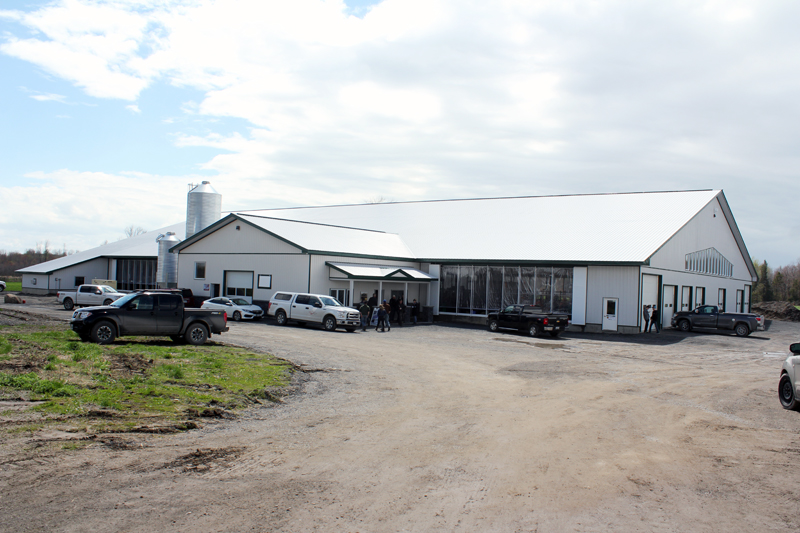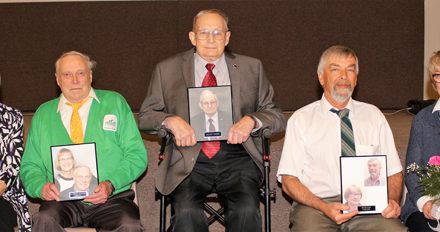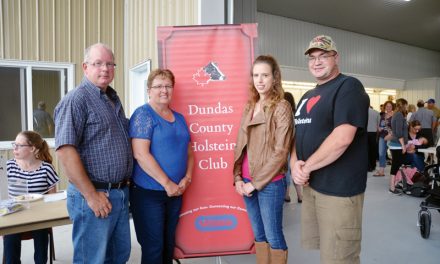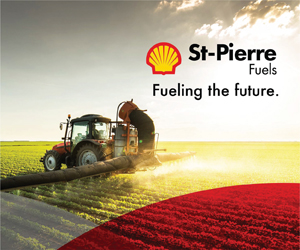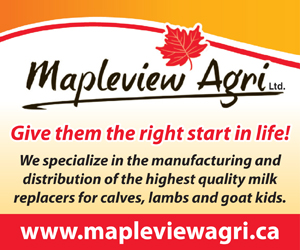From tie-stall to freestall
The Overvest’s newly built freestall barn was open for around 1,000 visitors on Sat., May 6. The barn was occupied by January 2017. Vogel photo
by Kalynn Sawyer Helmer
AgriNews Staff Writer
L’ORIGINAL – Overdale Farms held an open house on Sat., May 6, from 10 a.m. to 4 p.m. The farm was displaying their new 136 ft. by 222 ft. freestall barn and the many features inside to up production and keep their dairy cows comfortable. Morgan Overvest estimated a continuous stream of approximately 1,000 guests made their way through the barn to check out the features and support their friends.

The new Lely Juno 150 feed pusher was on display at Overdale Farms Open Barn on Sat., May 6. The robot sweeps the hay closer to the cows to make it easier to reach. Vogel photo
Overvest said the farm, “wanted to give everyone a chance to come see [the barn] without feeling like they are taking up so much time.” The Overvests moved into the newly built barn on Jan. 11, and are expected to be at capacity by late July. The barn has room for 120 dairy cows and suggested loads for two milking robots is 110.
The new barn sports two Lely Astronaut A-4 milking robots and a Lely Juno 150 feed pusher. Despite the well-known benefits of milking robots for freeing up a farmer’s time and allowing more flexibility in farm ownership, there are also a number of benefits to the cows themselves.
In terms of animal welfare and comfort, freestall barns allow the animals to walk around freely, lie down when they like, eat and be milked when they choose. This leads to happier animals which leads to better milk production said Dundas Agri Systems General Manager Levi Dejong. Freestall barns also lend themselves to ventilation and sand bedding all making the animals more comfortable.
“The milking robots are made for cow comfort,” said Dejong. The robots can milk each cow 3.2 times per day. This helps the animals produce more milk and become more efficient producers of milk since they can be milked when they want. The robots also can lower costs in the long run. Hiring on one farm hand to do one of the milkings a day, for seven days a week, every day of the year can add up costs. Dejong was adamant to explain that the robots in no way suggest a lazy farmer, but one who understands that the robots can unleash the full genetic potential of their animals.
The milking robots can even identify which cows are producing more milk and those that are not. It then combines with the feeding technology to reward the higher producers and modify the food for lower producers. Ensuring the lower producers do not get overfed.

One of the two new robotic milkers at Overdale Farms was on display for guests during the Open Barn on Sat., May 6. The two Lely Astronaut A-4 robotic milkers can handle 110 cows per day in the brand new freestall barn. Vogel photo
While the new technology is a good perk, Overvest explained that it wasn’t necessary for her to come back to the farm. Overvest was working for Holstein Canada and spent her time visiting farms. With each farm she would visit, Overvest would feel a longing to be back on her own family farm. As the only sibling interested in taking over, the thought was always in the back of her mind. This was until it became time for the Overvests to build. There needed to be a decision made of whether to downsize or grow, and Overvest’s parents, Gary and Linda, were looking to free up some of their time as they get closer to retirement.
This does not mean Gary and Linda Overvest will be quitting anytime soon, however. Morgan Overvest explained that since coming back in November, the family has been focused on farm operation and the new barn. Talk of business is on the back burner at least for a short while. Overvest said it will be a slow transition since her parents still feel young enough to be active on the farm. Overvest recalled her parents joking that they will retire to 40-hour weeks with her return.
Overall, Overvest could not say for sure whether the trend of women taking over farms and positions in agriculture is relatively new or is more noticeable to her now that she is in a position of future ownership. However, she did say the robotic milkers do help to make running a milking operation single-handedly, less intimidating. With many of her female friends doing similar transitions, Overvest said it is nice to feel as though there is a supportive community of women farmers.

